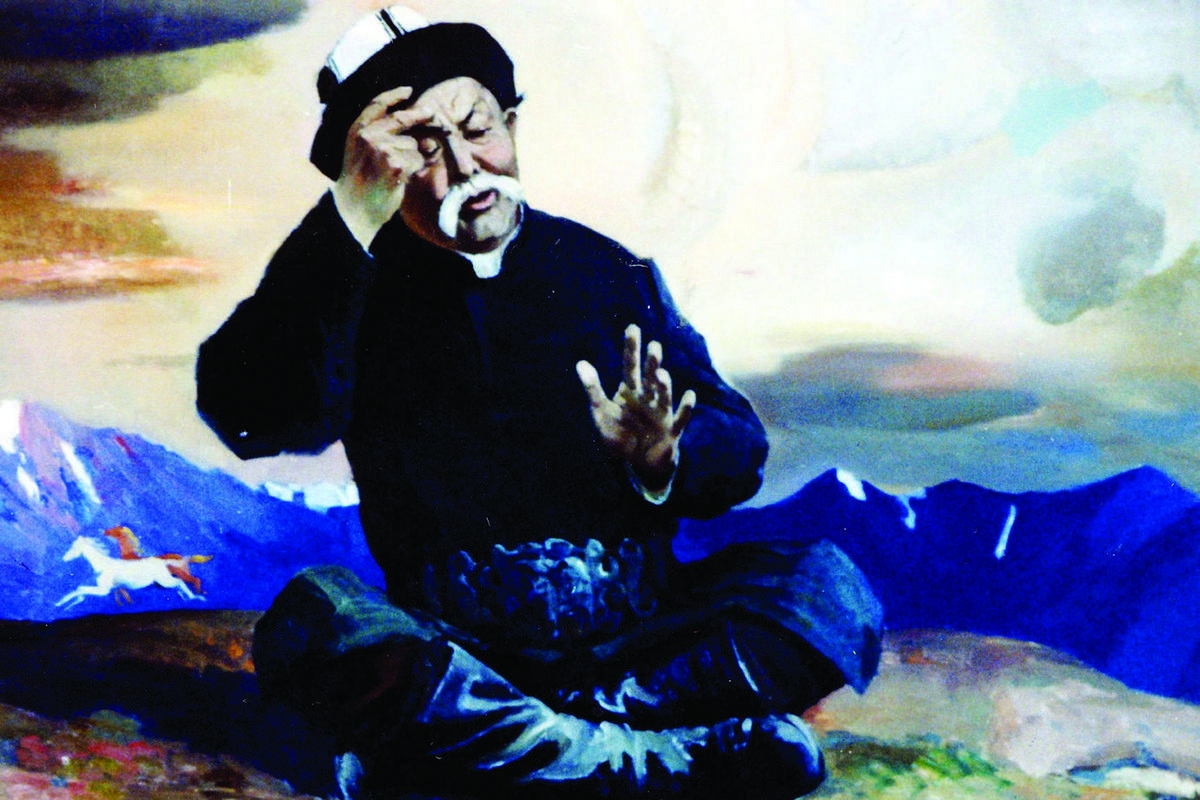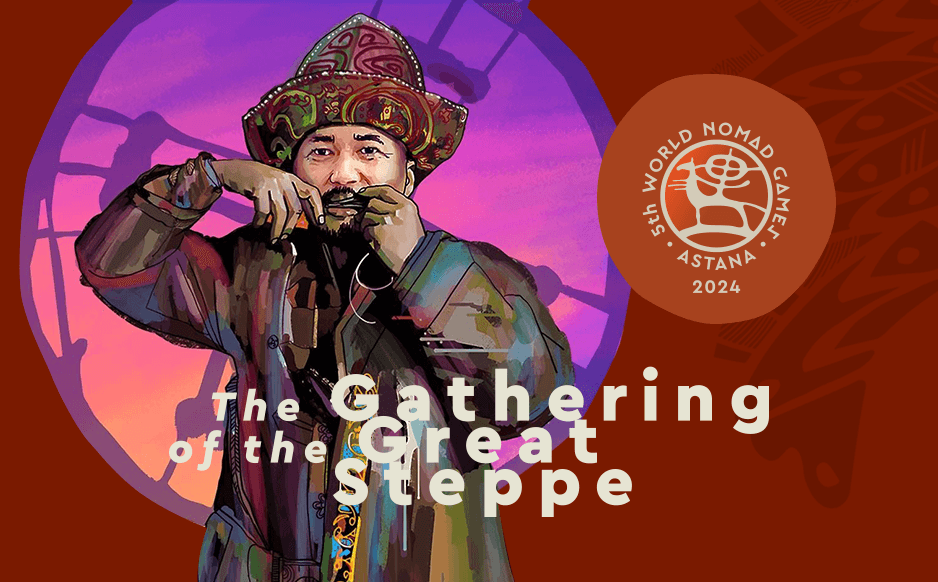Epics
Kyrgyz epics were passed from mouth to mouth– storytellers memorized texts of enormous size. Storytellers telling about feats of Manas and his descendants have a specific name – manaschy. These are the special people telling the great epic by falling into a trance, and the most legendary of them could continue a narration for days without a break. Although the most esteemed epic was and remains “Manas”, Kyrgyz folklore has a set of other interesting works.
“Kozhozhash”
One of the most ancient epics, “Kozhozhash” was created during the era of a tribal system. In it, as in the epic “Er Toshtuk” (created approximately at the same time), the early Kyrgyz system is traced, and the belief of Kyrgyz in a totemizm is noticeable. The work dazzles with its mythological creatures, against which the lone hero fights, defending the interests of his family. This biggest difference of early epics like “Kozhozhash” or “Er Toshtuk” from, for example, “Manas”, is that in the earlier epics, the hero is fighting for the interests of his family and people. Er Toshtuk and Kozhozhash’s enemies are monsters of the underworld and unknown creatures of nature, whereas enemies of Manas are strangers, threatening native land.
Kozhozhash is a hunter, who dreams to catch the female deer of incredible beauty, which, of course, would be the fairy forest. He was a daring hunter, so he could rescue the clan from hunger after long winter, and they all believed in his omnipotence and stopped eating pets’ meat, knowing that Kozhozhash will always bring a catch. So their attitude to nature is becoming consumeristic and predatory, and this nature can not forgive. The deer (female of a mountain goat) – Sur Echki, is prolific mother of many kids, and a fairy (goddess). She allows them to hunt her, but only for the sake of food and livelihoods reasons, instead of passion. Once a person has crossed the line – she will respond, which is why the successful hunter perishes, having almost exterminated all the children of the divine deer, but does not catch the deer itself. The morality of this epic reminds man that Mother Nature should be treated with care.
“Er Toshtuk”
Er Toshtuk is a hero who can be found in epics of many other nations. He goes down into Hell to release the souls of relatives captive there. Trying to achieve this goal he fights against mythical beings, djinns, and maidens. The epic was written down for the first time by the Russian turkologist Radlov – he heard it from the unknown storyteller in the settlement Shamshy, and later the best version of the epic was recognized as the one by the great storyteller Sayakbay Karalayev, and the epic became the object of scientific research of a number of scientists and literary critics. The epic evolved over time – from the ancient tribal epic about the loner hero to the epic about the one of characters of “Manas”. As expected, Er Toshtuk is a unique character – he is born to aged parents, grows by leaps and bounds, learns that his nine brothers have disappeared without a trace, finds them, and after, finds them brides, and then he himself marries. Versions of this epos can be seen in many fairy tales of the world – the youngest son is a hero who rescues all, the father bungler caught by witch and left as a deposit for the soul of his son, the beloved that gives the hero a magic horse, who will carry out a half of affairs for the owner, animals whom he rescues – and they answer it with the same. There are also cyclops, firebirds and a villain, whose soul is hidden in the trunk of the tree.
“Kurmanbek”
With Kurmanbek, perhaps, a new stage of epics starts: the characters are not fighting against demons and wizards, but against foreign invaders. When looking at subsequent epics, it is easy to find a historical stage which at that moment passed, because enemies were absolutely real – Zhunghars (Kalmaks) and others. What is more characteristic, is that quite often the hero dies not from the hands of enemies, but from the strife within the tribe, and from betrayal.
Kurmanbek is a young hero, stubborn and belligerent, a true leader who has managed to raise the people up against the colonizers – the Kalmaks. His heroism makes him well-known, and his glory runs far ahead, and there is only one problem – his father cannot reconcile the fact that authority of his son among the people is high above of his. That is why he betrays his son: at the right time he takes away a strong horse and replaces him with a weaker one. Unable to get out of the siege on a weak horse, Kurmanbek is fighting to the last, left by everyone except for his one friend. The soldier perishes in the battlefield, previously asking his friend to take care of his son.
“Zhoodarbeshim”
For Kyrgyz peoplem family has always been important, and genealogy, because of the myths and epics, has continued. Thus, for example, Zhoodarbeshim, the son of Er Toshtuk, is another great hero of this clan. He continues to struggle with mythical enemies of his father – witches, demons and giants.
“Janysh-Baiysh”
This is an epic about two brothers-heroes from the 16-17th century. According to this story, two brothers meet two feather-fairies, and marry them. Seeing them as powerful enemies, a Kalmak governor sends a spy to their camp, who becomes a “friend” of the brothers. It takes five years to implement the plan, but the betrayer finally traps brothers. Enemies surrounded unarmed brothers: one is captured, and another is wounded. However, Janysh will manage to escape and heal himself with herbs. Further, the plot develops in the spirit of the Greek myths – the imperial daughter helps Baiysh to escape, and reunite with the brother and soldiers, who already appeared in time of need, and together they defeat the enemy. Meanwhile, the homeland is in the heat of a quite Odyssey-like history – the throne was taken by slaves, willing to marry imperial wives, and brothers get back home as dervishes. Certainly, in the last scene the whole truth is discovered, and the traitors are put to death, and the governors are honored. The Kazakhs, Uzbeks and people of South Siberia have similar epics with different names.
“Er Tabyldy”
The soldier Er Tabyldy rescues the Kyrgyz people from Kalmaks and internal enemies like relatives as well, and, diverging from Kurmanbek, Er Tabyldy has the support of faithful Ermek and Eldiyar and defeats all the enemies.
“Janyl Myrza”
There is a place in the pantheon of heroes for a woman – and that woman was Janyl Myrza. She is a representative of the Noygut, a woman braver than many men. Not willing to pay tribute to their enemies, she successfully fights, but the enemy is also coming from the other side: three Kyrgyz khans are coming to Noyguts wanting to marry a beautiful woman-warrior and dominate the proud tribe. Not showing proper respect to the woman, they die at her hand. Having been frightened, other clans unite against her, and to avoid the destruction of her native people, she agrees on a shameful marriage with a poor old man. She would live out a miserable existence, if not for the invitation to the fighting competition: with her weapons, her courage and determination returned to her, she returns to native land and begins to fight for her people.
“Kedeykan”
“Kedeykan” is a real ode to cunning and resourcefulness. The main character is neither a warrior nor a defender, but a smart man Keydekan, who somehow begged the king to give him power for three days. By the end of the period it becomes clear that dodger does not intend to return power. He banishes the real ruler and remains on the throne.
“Ak-Moor”
Perhaps we should consider separately the epic of “Ak-Moor” – this ode to love has become a cult. The Gumbez, a building, is still on the road between Jol- Bulak and the road to large Kemin. As expected, there are few versions of the epic and they start quite the same: Khan Jantay sees on the street an unimaginable beauty and can not tear his eyes away from her beautiful face and truly graceful swan-like neck. He calls her Ak-Moor, believing that the swan comparison suited her much better than her name. He marries her. According to one version, she loves another man – a herdsman, and was forced to marry against her will, and after the death of the ruler she was killed, so she will not dishonor her late husband by returning to her herdsman.
According to another version she commits suicide, but it is improbable, because the Gumbez would not have been built then. The attitude toward suicide among the Kyrgyz people was the same as in all over the world: they are not buried in the cemetery, and their memory is not honored. According to the third version, the young girl was not only beautiful, but also intelligent and ambitious. With such beauty, she would marry without bride-price, but she saw as her husband only a decent hero. She learned that Khan will pass the coast of Son-Kul, so headed there and was spotted. Becoming the wife of the Khan, she was not just a decoration of the castle, but also a great adviser. He died, and before death he allowed the spouse, who gave him two children, to marry again. But she loved him, and every night went to his grave to sob. Fearing that the ruler would kill herself, her soldiers decided to kill her with her consent,a sort of a medieval euthanasia. Bayake-baatyr decided to take the sin on his soul, the faithful associate of the khan and a friend of the family. The Gumbez of a great ruler stands to this day: people come to her for help.
“Маnаs”
The Epic of Manas, consisting of three parts – “Manas”, “Semetey”, and “Seytek” – is included in the list of Masterpieces of UNESCO as the largest epic in the world, far longer than the works of Homer. According to the story, after the death of Nogoi Khan, the Chinese displaced the Kyrgyz people out of Ala-Too, and the khan’s son Jakyp was forced to work for the Kalmaks in Altay. After lots of effort, he becomes wealthy, but the fate does not give him a successor for long time: Manas is born when Jakyp is already old. Manas grows to be a real hero, as the Kalmaks reported to the Chinese governor, because he is a leader is rising among rebellious Kyrgyz people. At first, huge armies of the Kalmyk military leader Neskary try to destroy Manas, but the young man collects around himself separate tribes and defeats the military leader. Seeing in young man a future, not only the Kyrgyz, but also the Manchurs and the Kalmaks unite under his supervision. Further, one will find the description of feats of Manas, the description of feats of his colleagues as follows, each of which is worthy of attention. One should not forget that it is the longest epic on earth: it is impossible to retell it briefly. The quantity of feats that he acheives is much more than all other epic Kyrgyz heroes together, fighting real enemies, but also magical; for example, his Chinese friend Almambet’s marries the mountain fairy Aruuke. The Bukharan princess Kanykei, not only beautiful, but also capricious, strong and wise, becomes the wife of Manas, and she will keep and hide the grave of the spouse in the future, fearing that it will be profaned by enemies, and she will retain the memory of a great hero. In “Manas”, techniques from all previous epics are used: from the very beginning it is a loner hero who tries for the sake of his family, then he turns into a great hero, and returns to his people’s homeland. Here are strangers and enemies, and envious relatives preparing betrayal and “friends” dreaming to pacify the heat of a soldier, a warrior woman as Kanykei, and a love story, which occupies a separate branch in this work.





